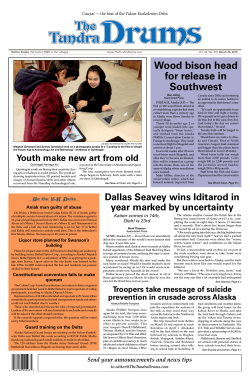
Alaska Airline`s Kris Kutchera Advocates for STEM Education
Special Section Alaska Airline’s Kris Kutchera Advocates for STEM Education Bulletin of the Association for Information Science and Technology – February/March 2015 – Volume 41, Number 3 by Steve Hardin 2014 Annual Meeting Coverage EDITOR’S SUMMARY Kris Kutchera, vice president for information technology for Air Alaska Group, shared her passion for education in a plenary session at the ASIS&T 2014 Annual Meeting. Kutchera learned early that study and preparation lead to competence, and she shares her values through Air Alaska’s commitment to youth and education. Her concentration in STEM subjects led her to information technology, applied to airline operations in a variety of ways from equipment weight reduction for fuel efficiency to passenger kiosks with virtual assistants and biometric finger scanning. Such innovative changes rise from understanding of business drivers and goals. Alaska Airlines trains all personnel in business basics and seeks out those with leadership and technical skills. Kutchera applauded ASIS&T members for promoting education that puts knowledge and information in action in STEM careers. KEYWORDS information science information technology education career development leadership youth Steve Hardin is reference/instruction librarian at Cunningham Memorial Library, Indiana State University. He may be reached at Steve.Hardin<at>indstate.edu. SIS&T members are well situated to help encourage more young people to develop into creative, excellent and passionate professionals. That is the opinion of Kris M. Kutchera, Alaska Air Group vice president for information technology, speaker at the first plenary session of the ASIS&T 2014 Annual Meeting in Seattle. Kutchera began by observing that she did not even know an association such as ASIS&T existed until president Harry Bruce invited her to speak. That shows how much we need to get the word out! She says she shares ASIS&T’s “tremendous passion for education.” Her passion started early, playing school in her basement in second grade. She had a lot of support from her parents, who encouraged her to get an education and do something with it. Her mother always told Kris, “You can do anything you want and be anything you want.” Her father taught her there is a method for anything you do. She carried both of these messages throughout her schooling. Kutchera said her best school experience was in her eighth grade algebra class. Her teacher would pick 10 kids at random to go to the blackboard and do homework problems. Then the other students would critique the work. No one wanted to come to class unprepared. So everyone practiced; through that practice they gained competence. She found that algebra was the key to every STEM class she took. So her parents were right: she could do anything so long as she mastered algebra. She presented an overview of the Alaska Air Group. The company started in 1932 in Alaska, but it is now based in Seattle. Its planes fly up and down the west coast, as well as across the country and to Hawaii. It is a $5.2 billion dollar company, the sixth-largest U.S. airline with 13,000 employees A 30 CONTENTS < P R E V I O U S PA G E N E X T PA G E > NEXT ARTICLE > 2014 Annual Meeting Coverage Special Section Bulletin of the Association for Information Science and Technology – February/March 2015 – Volume 41, Number 3 HARDIN, continued and 185 airplanes. They try to be fuel-efficient; it makes things more cost effective. Most of Alaska Air’s operations are in North America, but most of its customers like to fly worldwide. So the company has a lot of partners, such as American, Delta and others. It is the only North American legacy air carrier that has not gone through bankruptcy. The goal is to stay independent, and to stay that way, the company must perform. Everything depends on the employees, she says. In return for great jobs and great pay, the company asks for great employee productivity. If employees reach their goals, everyone gets a bonus worth 5% of their pay. Alaska Air believes that if everyone works together, they work better as a company. She says safety is paramount. Giving back to Alaska Air’s communities is a big part of who they are, with a primary focus on youth and education. The idea is to grow the service through low costs and low fares, producing strong returns for the owners and employees. Kutchera points out that many things are beyond the company’s control: weather, the economy, fuel prices. Managers focus on how to control the things they can. For example, the company flies a fuel-efficient fleet to make fuel costs more controllable. Information technology is essential for its success. An airline is a vastly complex operation. Everything must come together at the right time for success. Alaska Air, Kutchera says, was one of the first airlines to enable ticket sales on the web. It was also one of the first to have kiosks where passengers can get their boarding passes. “Ask Jenn” is a virtual assistant created by a student at the University of Washington Information School. Fifteen percent of Alaska Air’s check-ins are now made via its mobile app. Nearly all the company’s airplanes feature Wi-Fi and power. The company has leapfrogged over seatback entertainment to provide streaming, which is a better entertainment option. Connectivity for nearly every customer on the plane opens up a world of possibilities. Soon, passengers will be able to print their bag tags at home, too, so that it will not be necessary for an agent to do it for them. The company is also testing biometric finger scanning for access to its airport lounges. Kutchera says there are other innovations she cannot discuss yet. The airline is also taking a mobile-only strategy with its employees. Most of the company’s 13,000 employees do not work at desks. More and more, their communication is through mobile devices. In 2010, when iPads were new, an employee showed her how he had downloaded all the company manuals onto it. It showed that if employees could download the information they need to perform their jobs, they would not have to carry heavy flight bags anymore. Now that they do that, the fuel savings from not carrying those bags has paid for the devices. Not too long ago, when a mechanic would be alerted to a pending problem, he or she would print out the manual page needed to address it; if another problem was found, the mechanic would have to go back and print out another page. By putting the manuals on the mobile devices, the company can save 30 minutes per day per mechanic. That’s huge when you are operating on slim margins, she says. By the end of 2015, Alaska Air plans to have devices for all employees. Employees will have information they can share with customers, which means better service. Kutchera says the definition of innovation is “solving a problem or providing a value in a new way.” There’s nothing about technology. Business leaders need to understand the drivers and strategies for their businesses, then go out and look for ways to move the needles. Lots of times, she says, new technology is the last thing they do. Then they measure the results of these innovations in terms of business results. An airline is a very tangible business, she notes. You can see the results; your neighbors can talk about the results you have just achieved. All this innovation depends on people. In the last couple of years, the airline has increased its commitment to technology. Her team has grown. People are thinking about the type of talent needed to grow the organization. There are technical jobs (technology, engineers, web designers, analytics and so forth), as well as leadership positions (project management, change management, vendor management, basic people management). Kutchera says it is very hard to find people with these skills, and they make all the difference. Alaska Airlines is training its employees in the basics of that business. All the leaders received leadership training. They know much about how the company works and what is important to the airline and its culture. She said her ideal employees have “CREAPY” 31 CONTENTS TOP OF ARTICLE < P R E V I O U S PA G E N E X T PA G E > NEXT ARTICLE > 2014 Annual Meeting Coverage Special Section Bulletin of the Association for Information Science and Technology – February/March 2015 – Volume 41, Number 3 HARDIN, continued characteristics: Creative, Results-oriented, Excellence, Articulate, Passion, Yes (with an optimistic can-do attitude). Speaking to the educators in her audience, Kutchera says they are in a tremendous position to provide these people to a world that is looking for them. Talented people are in short supply. She notes that the state of Washington is #1 in the concentration of STEM jobs. Currently more than 25,000 jobs are unfilled in the Puget Sound region; experts predict 59,000 will be unfilled by 2017. Some 130,000 children start school in Washington each year, but only 8,000 (6%) take in-state STEM jobs. There’s a lot of untapped potential. Three-quarters of living wage jobs in the future will require some familiarity with STEM disciplines, she says. That means there is a huge talent gap, but also a huge opportunity gap. This gap contributes to lower living standards. Minorities are underrepresented. African-Americans, Latinos and Native Americans hold only 10% of the science and engineering jobs, even though they represent 30% of the working population. Among 18-24 year olds, 40% are underrepresented. The good news, she says, is there is a huge amount of untapped potential. “Pledge it. Prove it. Take flight.” is a program done in one of the hangars to inspire kids to finish their education and then go and do what they want to do. It’s inspiring to see kids pledge to finish their education. She would like to see equal access to opportunity. She would like to see more teachers of color. She also wants to see more organizations like ASIS&T and the iSchool program that work on the interplay between knowledge and information, because that will spread the wealth and get more people involved in this mission. She would really like to see professionals, businesses and others get more involved in getting kids more excited about STEM. She believes our future depends on these things. Kutchera concluded by asking audience members what they can do to inspire and encourage others to pursue STEM careers. ■ 32 CONTENTS TOP OF ARTICLE < P R E V I O U S PA G E N E X T PA G E > NEXT ARTICLE >
© Copyright 2025


















